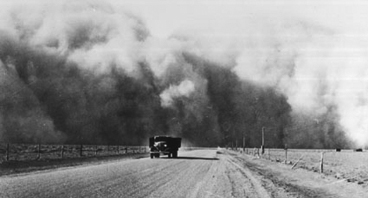
In the early 1930s, along with the greatest depression this nation ever experienced, came an equally unparalleled ecological disaster known as
the Dust Bowl. Following a severe and sustained drought in the Great Plains, the region's soil began to erode and blow away, creating huge black
dust storms that blotted out the sun and swallowed the countryside. Thousands of "dust refugees" left the black fog to seek better lives.
These storms soon stretched across the nation. They reached south to Texas and east to New York. In these years before air conditioning, dust
sifted into the White House and onto the desk of President Franklin Roosevelt. On Capitol Hill, while testifying about the erosion problem, soil
scientist Hugh Hammond Bennett threw back the curtains to reveal a sky blackened by dust. Congress unanimously passed legislation declaring soil
and water conservation a national policy and priority. Since about three-fourths of the continental United States is privately owned, Congress
realized that only active, voluntary support from landowners would guarantee the success of conservation work on private land.
In 1937, President Roosevelt wrote the governors of all the states recommending legislation that would allow local landowners to form soil
conservation districts. South Carolina’s Governor, Olin D. Johnston signed the S.C. Conservation Districts Law on April 17, 1937.
In 1938, the Greenville County Soil & Water Board of Supervisors met for the first time. In their Annual Report to the County in July 1940,
J.L. Lindsey, Chairman wrote, "The attitude of the farmers towards soil and water conservation is good, but they do not fully understand it. There
is a need to hold meetings to teach the people the value of conserving the soil. Those who do not know about the programs should be educated. Many
farmers are slow to take on to new things, but once they are made to see the value, they are glad to go along with it."
The S.C. conservation districts law established the working partnership between the United States Secretary of Agriculture, the State of South
Carolina, the S.C. Department of Natural Resources, and each conservation district in South Carolina.
With a five million dollar budget, the federal Soil Erosion Service set up demonstration sites in strategic locations throughout the United States.
One of the first demonstration sites in the United States covered the South Tyger River Watershed, located in Greenville and Spartanburg counties.
The project began on December 18, 1933 at the J.L. Berry farm, located near Poplar Springs in Spartanburg County where a gully, large enough to swallow
a vehicle, was repaired.
Over the seventy years of the Greenville Soil & Water Conservation District's existence, the goals remain the same: to install best management
practices to stop soil erosion and maintain good water quality and to educate the public about the importance of both.